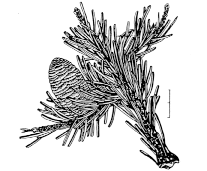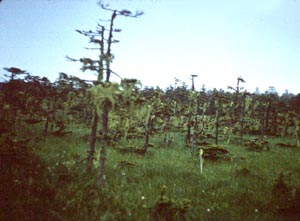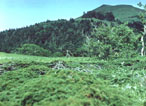Conservation Status

Abies sachalinensis
(F. Schmidt) Masters 1879
Common names
Sakhalin fir, トドマツ (akatodo) [Japanese]; Пихта сахалинская (pixta sakhalinskaya) [Russian]; fup, hup-chikuni, or yayu [Ainu].
Taxonomic notes
This is one of 8 species in Section Balsamea, which includes all of the Japanese and Russian Far East firs, as well as Abies balsamea and A. lasiocarpa in North America. Sakhalin fir is probably most closely related to A. nephrolepis, which occupies mainland habitats just west of the range of A. sachalinensis.
There are four described varieties, including the type, with synonymy as follows:
A. sachalinensis var. sachalinensis
- A. veitchii var. sachalinensis F. Schmidt 1868;
- Pinus sachalinensis (F. Schmidt) Vossin, Putlitz & Meyer 1913;
- A. nephrolepis subsp. sachalinensis (F. Schmidt) V.N. Voroshilov 1991;
- A. homolepis var. tokunaiae Carrière 1855;
- A. akatodo Miyabe ex Sargent 1893;
- A. sachalinensis var. corticosa Tatew. 1935;
- A. sachalinensis f. corticosa (Tatew.) Hayashi 1960
A. sachalinensis var. gracilis (Kom.) Farjon 1990
- A. gracilis Kom. 1901
- A. siberica var. gracilis (Kom.) Patschke 1935
A. sachalinensis var. mayriana Miyabe & Kudo 1919
- A. mayriana (Miyabe & Kudo) Miyabe & Kudo 1920
A. sachalinensis var. nemorensis Mayr. 1890
- Pinus sachalinensis var. nemorensis (Mayr.) Vossin, Putlitz & Meyer 1913;
- A. nemorensis (Mayr.) Miyabe & Kudo 1915;
- A. wilsonii Miyabe & Kudo 1919;
- A. sachalinensis var. wilsonii (Miyabe & Kudo) Viguié & Gaussen 1929.
Description
Trees to 30 m tall and 100 cm DBH, typically with a single straight round bole. Crown pyramidal, often becoming flattened in old trees, comprised of long, slender horizontal or ascending branches. Bark first brownish gray, smooth, with resin blisters; with age becoming a mosaic of gray-brown irregular plates. Twigs slender, stiff, brown, faintly ridged and grooved, with minute red-brown pubescence; leaf scars small and circular. Buds ovoid, small, very resinous, the bud scales persisting several years. Leaves spirally arranged, upper leaves covering the shoot, 12-35 × 1.2-1.5 mm, twisted at base, linear, flattened, grooved and glossy dark green on upper surface, with a midrib and two stomatal bands below; apex emarginate or obtuse, with few or no stomata on the upper surface. Pollen cones lateral, densely clustered, 1 cm long, yellow with red microsporophylls. Seed cones lateral, often crowded, ellipsoid-cylindrical with acute to obtuse apex, 5-8 × 2-3 cm, dark brown when ripe, with 10 × 16 mm reniform seed scales, pubescent on exposed surface, and 10-13 mm long included or exserted and recurved bracts. Seeds 6 mm long, brown with black spots, with a broad 5 × 5 mm black wing (Farjon 2010). See García Esteban et al. (2004) for a detailed characterization of the wood anatomy.
The varieties may be distinguished as follows (Farjon 2010):
| Variety | Bark | Leaf resin ducts | Immature seed cones | Range |
| A. s. var. sachalinensis |
Gray or brownish gray |
Medial |
Dark purple when immature; bracts exserted |
Hokkaido, Kuril Is., Sakhalin |
| A. s. var. gracilis |
Gray |
Marginal |
Purple when immature; bracts exserted |
Kamchatka |
| A. s. var. mayriana |
Smooth pale gray |
Medial |
Light purple when immature; bracts exserted |
Hokkaido, Sakhalin |
| A. s. var. nemorensis |
Gray |
Medial |
Bracts included |
Hokkaido, Sakhalin |
Distribution and Ecology
Russia: Sakhalin, the southern Kuril Islands, and one small stand on Kamchatka; Japan: Hokkaido. Occurs at elevations from sea level to 1,650 m; climate is cold maritime, and soils are well drained but perennially moist. On Sakhalin it primarily occurs at 800-1,100 m elevations in pure stands or a mixed forest with Picea jezoensis, Picea glehnii, and Larix gmelinii var. japonica or, near the treeline, Pinus pumila. At lower elevations it co-occurs with broadleaf trees such as Betula ermanii, Acer spp., Quercus mongolica var. grossesserata, Castanea crenulata, Kalopanax septemlobus, and Magnolia hypoleuca (Farjon 2010).
Distribution data from Conifers of the World BRAHMS database and GBIF.org, both downloaded 2017.11.04. Occurrences cited by Semerikova and Semerikov (2007) are also shown. Varieties of A. sachalinensis are color coded: orange for var. sachalinensis, blue for var. mayriana, yellow for var. gracilis, and red for specimens with no stated variety. Note that none of these collections report var. nemorensis. Click on each occurrence for further information.
Var. gracilis is only known from one small grove (0.2 km2) in Semyachik valley, Eastern Kamchatka (within Kronotsky Zapovednik); it was probably introduced here by native people few hundred years ago (Harkevich and Kachura 1981), but may be a Tertiary relict occurrence, in which case it would be an extreme biogeographic anomaly (Farjon 2010); Abies is otherwise unknown in Kamchatka.
Recruitment in this species is dependent upon dead wood, i.e. most seedlings recruit upon fallen logs (Lian et al. 2008). A similar dependency is seen in Picea sitchensis and Tsuga heterophylla in the Pacific Northwest.
The species (variety unspecified) is hardy to Zone 5 (cold hardiness limit between -28.8°C and -23.3°C) (Bannister and Neuner 2001).
Wilson (1916) says it is abundant in Hokkaido, occasionally in pure stands but usually with Picea jezoensis and deciduous hardwoods, or, in the northern part of the island, with Picea glehnii. In Sakhalin (which at the time was Japanese, south of 50°N), he found that it "covers enormous areas" with Picea jezoensis and Larix gmelinii var. japonica, chiefly on low mountain slopes.
Remarkable Specimens
Wilson (1916) says the largest trees he found were "on the slopes of Shiribeshi-san near the town of Kutchan up to 1000 m. altitude" and were up to 250 cm girth (about 80 cm dbh) and 30 m tall.
Ethnobotany
The Ainu would use the wood for construction or making tools, containers, and other necessities. They would also hunt bear using traps armed with poisoned arrows; Abies sachalinensis resin was used to seal the poison (extracted from Aconitum sinense) into the base of the arrow tip. The resin and the poison were both deified in recognition of their role in sustaining the Ainu hunting economy (Williams 2017). Williams (2017) also says "There are many references to it in Ainu place names that would seem to indicate it was long important to them" and "In Kushiro, there is a dance celebrating the Sakhalin fir in which the female dancers make their hair swirl around their heads to symbolize the power and energy of fir branches in the winter wind." Citing historical sources, she says "Matsuura reported that he witnessed some Ainu making an overnight shelter of its bark at the village of Kikinnai, during his journeys to Bihoro in northern Hokkaido at the end of March 1858. He noted that it was relatively
easy to debark sections 5 to 6 ft long in spring, but this was more difficult in winter when the sap was frozen. The branches and needles were used to make temporary shelters, called fup-cise or fupkar-cise. The branches were lashed together to form a frame; smaller branches were interwoven with them to form the walls; other small branches were spread on the floor and needles
placed over these to form places to sit or sleep. In the centre of the hut, they spread some soil and on it they built a fire." The plant also had medical and ritual importance: in Sakhalin, when a sick person visited another’s home, he had to purify himself by gently striking himself with the branch of a Sakhalin fir, then placing the branch in the crotch of a tree facing in the direction of the sunset. An ill person would offer prayers to the god of the Sakhalin fir in the hope that it would hasten recovery.
This species is logged for pulp (the timber is of low quality). It is rarely seen as an ornamental and only does well in arboreta that experience cold enough winters to force it into winter dormancy (Farjon 2010).
Observations
No data as of 2022.12.31.
Remarks
The epithet sachalinensis refers to Sakhalin Island, the type locality, where it was discovered to science by the German botanist Carl Freidrich Schmidt in 1866.
Citations
Harkevich, S. and N. Kachura. 1981. Rare Plant Species of The Soviet Far East and Their Conservation. Nauka, Moscow (in Russian).
Lian, C., S. Goto, T. Kubo, Y. Takahashi, M. Nakagawa, and T. Hogetsu. 2008. Nuclear and chloroplast microsatellite analysis of Abies sachalinensis regeneration on fallen logs in a subboreal forest in Hokkaido, Japan. Molecular Ecology 17:2948-2962. doi:10.1111/j.1365-294X.2008.03802.x.
Masters, M.T. 1879. The Gardeners' Chronicle ser. 2, 12:588, fig. 97.
Semerikova, S.A. and V.L. Semerikov. 2007. The diversity of chloroplast microsatellite loci in Siberian fir (Abies sibirica Ledeb.) and two Far East fir species A. nephrolepis (Trautv.) Maxim. and A. sachalinensis Fr. Schmidt. Russian Journal of Genetics 43(12):1373-1381.
Williams, Dai. 2017. Ainu Ethnobiology. Tacoma, WA: Society of Ethnobiology. ISBN 978-0-9887330-7-7 (PDF). Pp. 34, 53, and 153.
See also
Elwes and Henry 1906-1913 at the Biodiversity Heritage Library. This series of volumes, privately printed, provides some of the most engaging descriptions of conifers ever published. Although they only treat species cultivated in the U.K. and Ireland, and the taxonomy is a bit dated, still these accounts are thorough, treating such topics as species description, range, varieties, exceptionally old or tall specimens, remarkable trees, and cultivation. Despite being over a century old, they are generally accurate, and are illustrated with some remarkable photographs and lithographs.
Farjon, Aljos. 1990. Pinaceae: drawings and descriptions of the genera Abies, Cedrus, Pseudolarix, Keteleeria, Nothotsuga, Tsuga, Cathaya, Pseudotsuga, Larix and Picea. Königstein: Koeltz Scientific Books.
- Provides a detailed account, with illustrations.
Iwatsuki et al. (1995).




